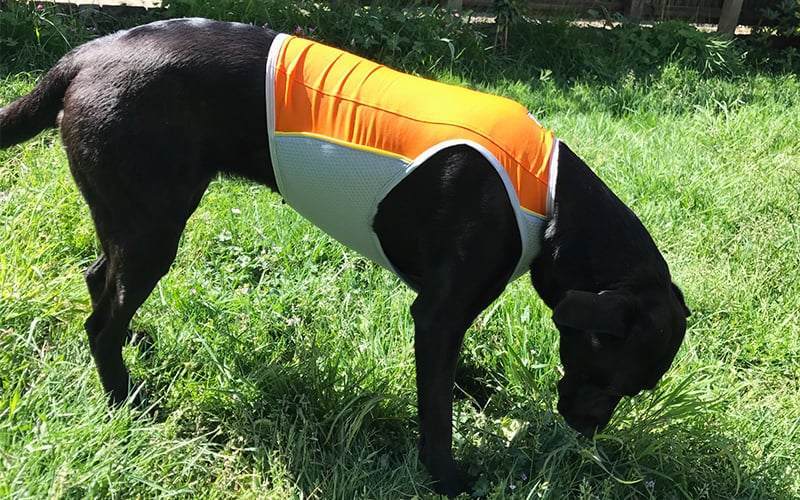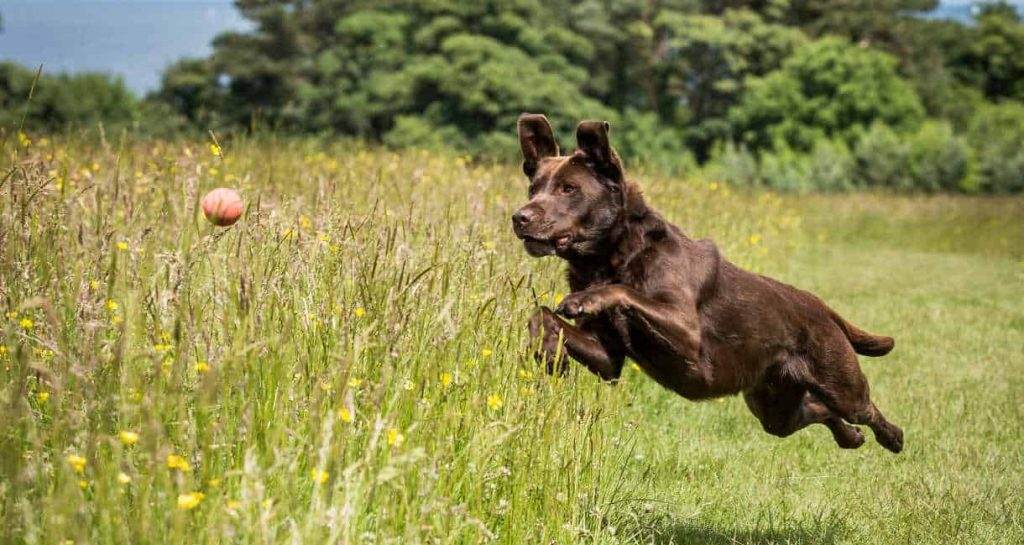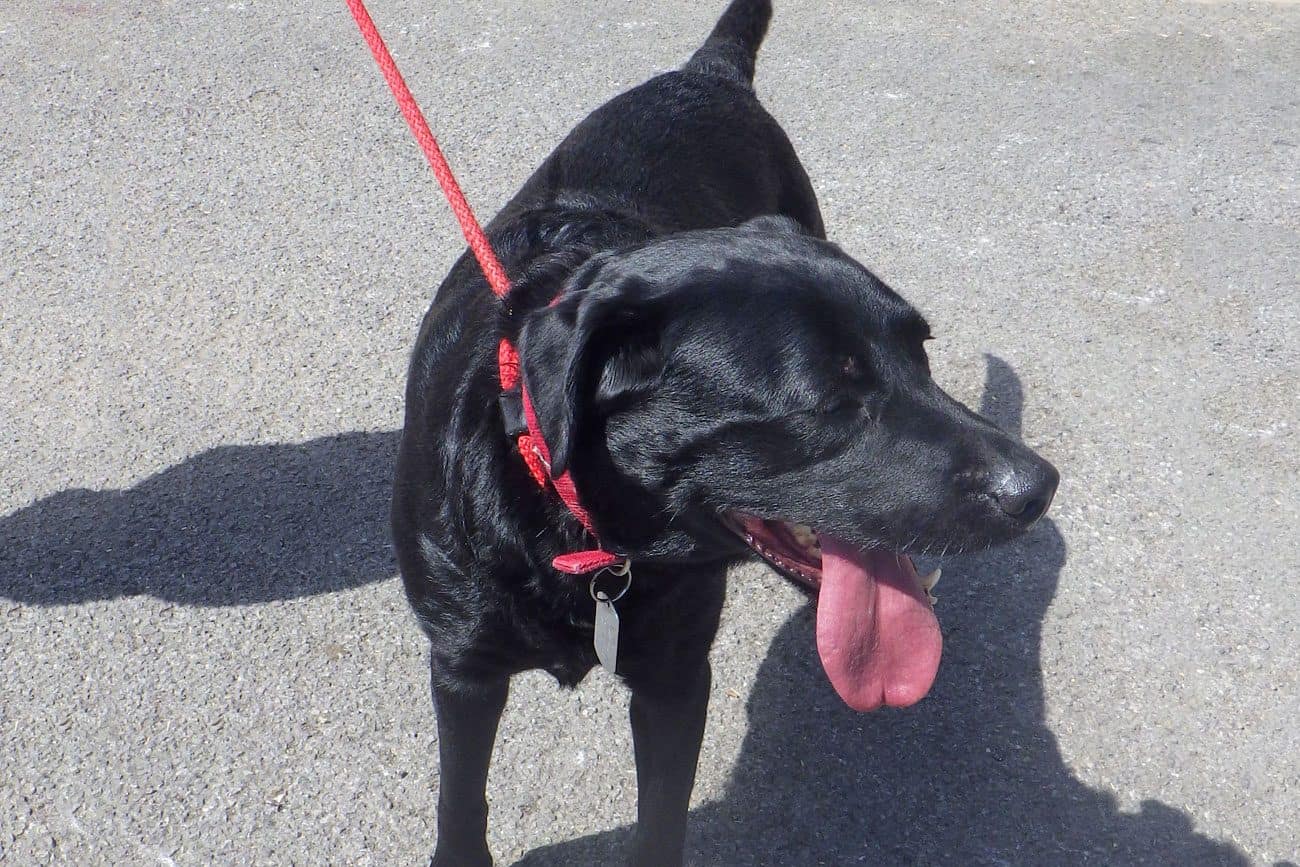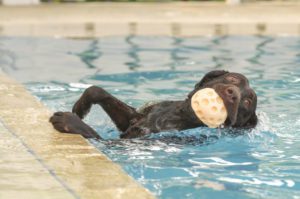Summer season sucks all that energy from you. As the temperature rises, it becomes difficult not only for you but also for your Labrador retriever. Hence if you want to take good care of your family member then you should be first gaining information, facts, and knowledge which this article will provide. You should know:
- What temperature level is ideal for Labrador
- What temperature is too hot for them?
- How can you keep the temperature on check and help the Labrador to beat the heat?
It must be clarified here that every dog breed is different and every dog has different toleration levels. This applies to the training sessions, food and summer season too.
The suitable temperature for a Lab dog is roughly 32-degree C. If you convert that to Fahrenheit, it comes to be 90 degrees F. The easy solution is that if the weather report says the outdoors temperature to be more than the above readings, you have to bring your dog indoors. I have heard lot of horror stories due to heatwave. This is the reason we see so many videos of doing having chill time in the swimming pools in the evenings. Even street dogs would dig out and sit inside moist soil during the summer season.
Why Should You Worry About Temperature and Your Labrador?
The dogs’ body is not made to tolerate high temperatures. Human beings have sweat glands that produce sweat to keep the skin cool. No such mature body regulation is present in case of Labs.
While our bodies can tolerate frequent changes in weather too, dogs will fall ill if the weather is changing too frequently due to any reasons. We have natural instinct to add or remove clothes depending upon the outside temperature.
But your four-legged Lab dog is relying on his coat on which he has no control as such.
As soon as the outdoors temperature increases above 100-degree F, the air becomes hot. This results in rise of temperature of your dog’s body too. Eventually, as the outside temperature keeps on rising, it reaches a point at which the dog cannot tolerate it and gets affected by the heatwave.
Just a mere difference of more than 5 degrees above the toleration level is enough to cause bad effects on his body.
You will see him become lazy and it can be irreversible too if the rise in temperature extends for a couple of weeks. After that it becomes nearly impossible to reverse the bad effects that have already be done to him.
Thus, taking care of your dog in the summer season is of utmost importance.
Why Heat Stroke Attacks Labrador?
There are two terms in medical terminology named as hypothermia and hyperthermia. While hypothermia means the outside temperature is less than your body temperature (winter season), hyperthermia is it’s opposite and comes into existence during the summer season.
Let us first understand what is a heat stroke for dog and then we shall see how it attacks the dogs.
As per PetMD, Heatstroke is a form of non-fever hyperthermia that occurs when heat-dissipating mechanisms of the body cannot accommodate excessive external heat. Typically associated with a temperature of 106° F (41° C) or higher without signs of inflammation, a heat stroke can lead to multiple organ dysfunction.
It has been found that there is a co-relation between nose size and heatwave effects. The shorter the nose of dog, the higher the bad effects of heatwave on the dog. The dog breeds like Bulldog have shorter noses so better be careful with them and don’t let them catch heatwave.
A heat stroke is induced when the body temperature rises above the toleration level. As heatstroke has been named as Hyperthermia too. This can be caused by a number of other factors that include a lot of physical activity and brain malfunction.

The Other Factors Apart from Temperature
As soon as it starts raining in the summer season, the level of humidity will increase. The effect of humidity on humans is that we start to sweat a lot. However, it is also true the heat from the summer feels hotter. The dessert coolers fail in humidity and only air-conditioners can help out.
So, we should be looking at the humidity levels in the environment apart from the temperature. Almost all-weather channels do report the humidity levels in their daily weather report. Even smartphone apps also tell the same. When humidity is high, a day with 70 degrees F will feel more hotter than low humidity and 80 degrees F temperature.
In the areas where it rains a lot, humidity is always higher than normal. Hence the above toleration level of 100 degrees F doesn’t stand true. In those regions, the maximum limit for the Labrador dogs shouldn’t be more than 90 degrees F. The puppies will need even more care than grown-up Labs.
The after-effects of heatwaves are dehydration in the dog, painting, laziness and drooling.
What are the Clear Indications of Heat Wave in Dogs?
My professional vet Mr. Donald always says the following about Heat Wave in Dogs
- Dryness
- Painting
- Breathing issues
- Drooling
- Laziness
- Hot body
- Vomiting
If you see any of the signs especially in the summer season, immediately be on guard and be prepared to take him to the vet anytime.
If your Labrador already has some breathing issue then heat waves will show its effects many folds. Since he will be having pre-existing conditions, the heat on his body is only going to make the matter worse for him.
You also need to provide proper care to senior Labs in your home. They will drool a lot in the summer so they need more attention than younger Labrador Retrievers
How to Prevent Heat Wave Stroke
Here I am going to talk about prevention. If you can prevent your dog from getting heatstroke by the advice that I give in this section, I shall consider this whole article as a success. First I have listed the headings and then I have given details about each tip.
Best ways to prevent heatstroke in lab dogs, keep the dog cool in the summer season:
- Keep them hydrated with water
- Take them to the swimming pool in the evenings
- Don’t leave Lab alone in the car
- Take measures to give them shades
- In the summer season, you can delay shaving their coat
- Say no to materials like asphalt and cement
- Keep the Labrador Retriever cool with cold water-soaked clothes
- Give them cool with a fan or have them stay in the living area
- Keep their non-veg food in the frozen state with ice
1. Keep them hydrated
Now this will look obvious to you. We all drink cold water or other beverages when we feel the heat. The same applies to your Lab.
You or someone in your home needs to keep checking with the dog if they need water to drink. The heat will dehydrate a lot of water content from their body and the only way to replenish it by giving them more water frequently.
Water will keep their body temperature at the check and hence decrease the chances of heatstroke by 50%.
A bonus tip here is to add ice to their water to make and keep it cool. Warm water will not be liked by them at all. At least give room temperature water to cold water.

2. Take them to the swimming pool in the evenings
It is not very difficult for Labrador dogs to learn swimming. In fact, if you introduce water to them, there are going to thank you for doing it.
Initially, he may resist but when you show him hot to get wet, he will beat the heat by swimming. This method is used by so many dog owners that I know.
If getting access to the swimming pool is not possible to you, the Lab dog is not going to judge you or hate you for taking him to the pond in your neighborhood. One word of caution here is that let them dry out before taking dogs indoors else your floor and furniture will need extra money to repair/replace due to them getting wet.
3. Don’t leave Lab alone in the car
There is something known as the greenhouse effect when the glass is used as a container. Suppose you leave the Labrador dog inside a car with windows up, the heat will go inside the car and it gets trapped inside the car, making the car hotter by every minute Eventually, the car becomes so hot that it is not possible to sit inside it. This is why you cannot even think of leaving the Lab inside a locked car.
Even if the windows are down or AC is on, then also it is not a good thing to leave the dog alone. Either take him with yourself or leave them at home with a trainer or helper or family member.
4. Take measures to give them shades
The Lab dog will anyway be searching for shades. If you provide shades to them, it is only going to make it easy for them.
You can give them shades in the areas where they like to stay and go. These areas include dining place, sleeping or water bowl place. For some dog owners, all these places may be one single place and for others, they may prefer to provide different areas in their home for different purposes.
5. Delay shaving their coat
The idea with this tip is to not expose the Lab skin to direct heat. However, if you see the fur has increased a lot and is not only making your dog look bad but is ruining your household stuff, then you may think of getting a dog hair glove from Amazon.
Even then it just matters holding onto high-temperature months. As I said above, you can give them a small trim, use hair shedding gloves but its better if you don’t give them a cutting using scissors, etc.
6. Say no to asphalt or cement
You want to avoid giving your dog any kind of burns on his body. The most common place where they get burns is their paws. Not only burn painful to dogs but it reduced their physical activity and training sessions. We know how hot asphalt and cement get in the summer season and hence this advice is being given.
One other way you can save their paws from getting burns is by having them wear shoes. These are easily available on ecommerce websites like Amazon.
I would always use my hand to check how warm it is on the floor for the dogs. I would go to the door of my home and touch the road where direct sunlight is coming. If I feel it will be too harsh for the dog, then I keep them indoors and play with them.
The mornings and evenings are the best time when I can take them out for a walk without too much worry about burning their paws.
7. Use water-soaked clothes
The market is full of products that can give relief to dogs in summer. There are doggie pools and vests etc. The vest is an interesting product. You use it by first soaking it in water and then let the dog wear it for 10-20 minutes. Do note that it is not meant to be worn full time by the Lab. You can get one from Amazon here.
In case your first try out how it will feel like when your dog is wearing the vest then you can try with a towel. Just use cold water and let the towel remain in it for 10-20 minutes and then you can give it to your dog.

8. Use a fan or other cooling device
You use fans to deal with heat so can your dog. Give their sleeping and rest place, enough ventilation. As the air gets circulated, they will feel relief from the heat. The skin produces sweat in summer and as the air starts to dry out the sweat, the dog’s body starts to feel cool.
A ceiling fan or table fan helps out in this regard. If your dog already sleeps with you then you may already be turning on the Air Conditioner at night.
I do have a good recommendation of a fan for your Lab dog which will keep him cool in the summer. It’s available on Amazon too for easy purchase.
9. Keeping their food in a frozen state
When the dog’s food is in a frozen state, it helps during the heatstroke. The little ice on the food will help get some water inside their bodies. I have noticed then when the dog is suffering from heatstroke then they don’t like to drink water.
It can be any kind of food whether vegetarian or non-vegetarian.
Solutions and Treatment for Heat Stroke in Dogs
In this section, I will discuss what you can do when heatstroke has been diagnosed. These tips will help both a pup or a grown-up Lab.
1. Keep them cool using towels/rags
Apart from using a vest, you can also use a cool towel on his head. When the blood vessels are cool in the head, the circulation of blood inside is easy and keeps the temperature rise in check.
Wet rags or ice packs are good in this situation.
Do note that these little things make a huge difference to their body temperature. The proper health maintenance is in these small details.
2. Give him a freshwater bath
The other thing apart from giving them a cool towel is to give them a bath with fresh water. By fresh I mean normal temperature bath. In summers, the water in your tank may get hot. So, you want to first keep water under shades so that I cool down or you can add some ice to the water.
Once you feel the water temperature is something that the four-legged Lab will enjoy then you can give him a bath with it.
Do bear in mind that you cannot give too much bath sessions to your Lab as their coat may wear off. This coat on their skin has essential oils that protect their skin for conditions like dryness.
When it is not summer, it is advised to give a bath every 10-12 days. So this means that you can only give a bath to him when you see signs of heatstroke in your Labrador retriever.
3. Use Air Conditioner
Immediately on seeing any sign of heatstroke, the above two tips will help you out. The third tip that I have is to use an air conditioner. You want the body temperature to come down. To achieve this fast, you can take him inside your car and turn on the AC.
Make them it in the front seat. The AC in the car starts to show effect much faster than in your home because of the area. I have said this before and I repeat this again, never ever leave your dog inside the car alone.
It is never recommended even when the windows of the car are down. Taken him to the vet where you have been taking him for regular checkups. The vet will further guide you on the future course of action.
Frequently Asked Questions (FAQ)
I have put together answers to questions that I frequently receive on my Instagram account. These questions relate to providing proper care to the dog when summer sets on and also when the dog has been hit by heatstroke and you are trying to protect him.
I provide shade and that is all?
Only shades may not be sufficient. The point is to bring his body temperature down from 100 degrees F. Shades will help a lot but there are things also which you need to do. These include air circulation by using fans or cold-water vests. In a place that is already getting direct sunlight, the shade will not help much. Think of sitting in a car that is parked in direct sunlight during summer.
If you really don’t have time to check the temperature and health condition then better let him roam around in your living area. That way he will have some air conditioning, shades, and water to drink. The only issue that you may face is regarding cleanliness which is taking care of your furniture and taking him out for a pee.
It may be tempting to keep him inside a crate to avoid getting your home dirty. This is not the best approach. Every dog deserves to roam around and not be confined in a small space. The crates were designed for keeping dogs during special times like when there is construction work going on in your home.
Can I have physical activities with my dog during the summer?
Everybody on this hearth has to move his body including animals. The body will attract diseases if it is kept on rest. Hence you should definitely do exercises and play with your dog.
The advice that I always give on this question is that check the temperature. You don’t want to take your dog out when it is already hot outside. Keep him indoors if that is the case and play some indoor games. There are brain games that can be played with dogs. What I personally do is that I play with my dogs during the morning time before sunrise. The evening is also a good time to take your dog outside.
The joy you will have with your dog is nothing as compared to getting up early for having a good physical exercise with your family member.
The conclusion of this section is that when the dog is healthy then you should never ignore playing with him and channelize his energy with physical activities. If your dog knows how to swim, swimming is also a great physical exercise.

Conclusion
I have put together all the knowledge and covered a lot of topics which are essential when it comes to taking care of Labrador dogs in the summertime. There are a lot of things that can be done. Make sure to follow what I discussed above.
Always remember that our motive is to keep the dog’s temperature regulated. If any activity will increase it substantially then avoid doing that activity.
References
- https://onlinelibrary.wiley.com/doi/abs/10.1111/j.1748-5827.1992.tb01077.x
- https://link.springer.com/article/10.1007/s10071-016-0958-5
Table of Contents



